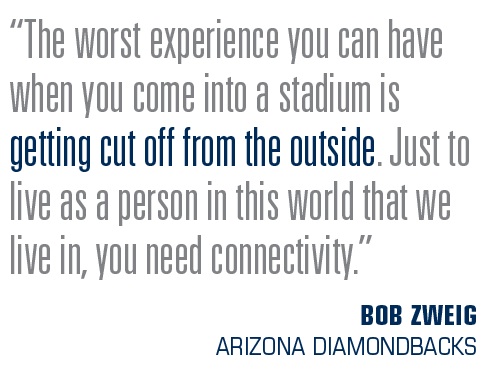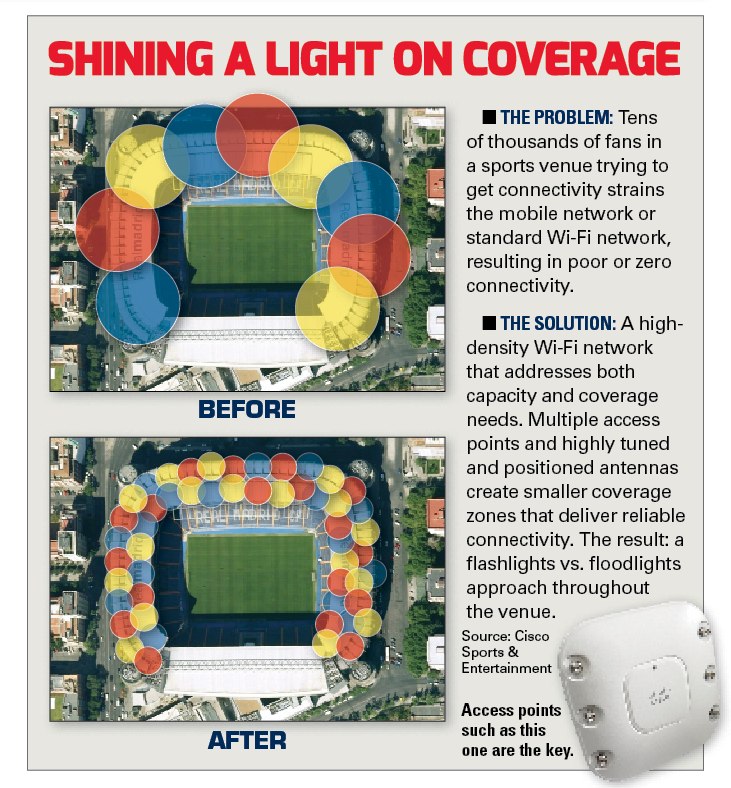Mercedes-Benz Superdome executive Dave Stewart peers into the future of sports and sees a point in time when every NFL fan’s mobile device is automatically connected the moment they walk through the stadium gates.
They will have exclusive content delivered to their devices, Stewart said, which could include listening to New Orleans Saints coach Sean Payton relay play calls to Drew Brees through the quarterback’s helmet microphone, or using their smartphone to find out how long it takes to buy a hot dog at the concession stand.
The San Francisco 49ers are already moving in that direction at Levi’s Stadium by developing a mobile application to pinpoint the shortest lines for concessions and restrooms when the facility opens in 2014.
It is just one more sign of how quickly mobile technology is revolutionizing the game experience at arenas and stadiums.
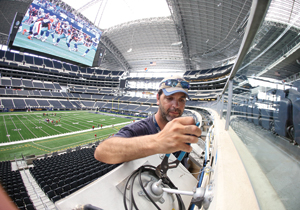 |
AT&T’s new naming-rights deal with the home of the Dallas Cowboys includes a major wireless upgrade featuring new Cisco hardware. An additional 350 access points in the seating bowl will improve coverage.
Photo by: James Smith |
How fast is the technology moving? By the end of 2013, the number of mobile-connected devices will exceed the world’s population of 7 billion, according to research compiled by Cisco Sports and Entertainment, a provider of wireless technology for sports facilities. By 2017, the number of mobile devices activated globally will jump to 10 billion. By that time, streaming video will take up two-thirds of the world’s mobile data traffic, Cisco officials said.
“I’ve read several articles that say by 2015 we will use our cellphones less than 5 percent for a phone,” said Stewart, SMG’s chief technology officer at the Superdome, home of the Saints. “The majority of use will be for streaming video, email, Twitter and Web surfing.”
The issue is of critical concern for sports properties competing against the home viewing experience. Teams recognize that providing seamless connectivity is no longer an amenity but a requirement for the fan experience.
In addition, the elevation of social media to a preferred mode of communication among younger fans has forced even the newest arenas and stadiums to boost their wireless systems to meet the demand for uploading photographs and video clips.
Two years ago in Major League Baseball, for example, close to 100 percent of fans attending games and using mobile devices were downloading information such as game statistics. Now, the trend has shifted to uploading, with 40 percent of all data traffic tied to people sending images to family and friends documenting their experience, said Bob Bowman, CEO of MLB Advanced Media. That trend, he said, requires changes to wireless systems.
Still, over the past few years, only 35 percent of all major league facilities have upgraded their wireless systems in the seating bowl and concourses to improve fan connectivity, said Bob Jordan, a sports technology consultant with Van Wagner Sports Group.
Part of the reason is that such projects aren’t cheap. Costs can run into the millions of dollars to install Wi-Fi
networks for all mobile devices, including computers and handheld equipment used to scan tickets or take food and drink orders in premium areas. Distributed antenna systems, meanwhile, are needed to provide coverage for cellphones and serve as backup to reduce loads from heavy use of Wi-Fi networks.
The projects raise the question of who will pay for the equipment and what business model will work to recoup some of the cost. In addition, the unique designs of arenas and stadiums, and the usage patterns that develop over time, provide technical challenges for installing that equipment. In several cases, the sponsorships teams sign with the likes of AT&T and Verizon are linked to agreements covering the costs for wireless improvements.
But the trend of a data-hungry fan base isn’t going away and team officials say the upgrades are imperative to keep fans going to the games and to provide the infrastructure required to support the mobile applications teams develop to drive incremental sales of tickets, food and merchandise.
“The investment is minimal in the scheme of things,” said Dave Holland, senior vice president and general manager of Cisco. “It’s the essence of why people are there. You want to be able to share content and have that conversation with friends and family about your experience there. And the teams and leagues also want to connect with you.”
Traffic jam
As more teams upgrade wireless connections at their facilities, they are marketing their buildings as exclusive content centers by developing mobile applications through which fans can access video content they can’t get anywhere else — even at home.
Last year, both the New York Jets and New York Giants, through their mobile apps, introduced multiple camera angles of game action for users of mobile devices at MetLife Stadium. The Brooklyn Nets do the same thing with Cisco’s StadiumVision Mobile at Barclays Center.
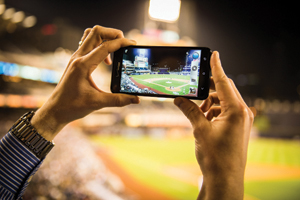 |
Over the past year, Qualcomm has been touring Major League Baseball’s 30 stadiums to survey the state of connectivity.
Photo by: Qualcomm |
The Dallas Cowboys will test their own streaming video component this season as part of Cisco’s massive wireless upgrade at AT&T Stadium, the vendor’s largest installation of its Connected Stadium Wi-Fi system among 50 projects worldwide. But showcasing the complexities of the space, the Cowboys have a separate partnership with local firm TPI for the stadium’s distributed antenna system where the two parties share revenue from the fees carriers pay to connect to that network
(see related story).
The popularity of mobile video is rising with lightning speed, another driving force for wireless upgrades at sports facilities.
In a few years, there will be “50 billion things connected and in sports those things can be balls, bats, pucks and goal posts,” said Mike Caponigro, marketing solutions lead for Cisco. “All those elements are going to continue to spin off data, metrics and video feeds to augment the viewing experience. We’re just scratching the tip of the iceberg with the potential of these platforms.”
The numbers are startling, underscoring the need for teams to have the proper wireless infrastructure in place to provide the quality of connectivity sports fans expect as part of their everyday lives. Ignore the trend and teams risk losing an entire generation of fans.
“The worst experience you can have when you come into a stadium is getting cut off from the outside,” said Bob Zweig, Arizona Diamondbacks vice president and chief information officer. “Just to live as a person in this world that we live in, you need connectivity.”
Over the past year, Qualcomm, an official technology partner of MLB Advanced Media, has been touring Major League Baseball’s 30 stadiums to survey their state of connectivity. As part of the project, Van Wagner’s Jordan developed benchmarks to measure the effectiveness of wireless systems.
In some ballparks, Qualcomm’s engineers discovered antennas facing each other instead of pointing toward the seating bowl, creating dead zones and cancellation issues, said Brian Dunphy, Qualcomm’s senior director of business development.
“A lot of these stadiums, too, are old and there are not a lot of areas you can put equipment in discreetly and not have interference,” Dunphy said. “Each ballpark creates a unique set of circumstances we’re taking a look at to optimize the best coverage throughout all areas of the park.”
To date, Qualcomm has surveyed about 20 ballparks and made recommendations for improving connectivity. Some upgrades have been completed with wireless carriers AT&T, Verizon and T-Mobile sharing the costs depending on the market and their team sponsorship deals, Bowman said.
“In general, we are under capacity, to the extent that if 30,000 to 40,000 people wanted to make a call or text at the same time, they are not going to be happy,” he said.
“We don’t think people should have to check their technology at the door. That’s why we are doing this survey. We knew that just by our own experimentation, going to a World Series game or an All-Star Game, connectivity is not where it needs to be.”
Seizing the opportunity
The mobile revolution has resulted in a new line of business tied to connectivity at sports facilities. Companies such as ExteNet, Crown Castle and Mobilitie (see listing) install distributed antenna systems to improve coverage for mobile devices.
These vendors serve as the middle man between teams and wireless carriers, signing deals up front with the building owner, whether it’s the team or a municipality. On the back end, they sign deals with wireless carriers to attach to the vendor’s system to provide coverage for their respective customers. The carriers pay fees to join these systems, providing one option for teams and cities to fund these multimillion-dollar projects.
At Amway Center, a publicly owned venue, the city of Orlando collected $201,788 last year through its deal with
Crown Castle, said Allen Johnson, the arena’s executive director.
There are some potential pitfalls to this model. For the past year, AT&T has refused to join distributed antenna systems that Mobilitie installed at Arrowhead Stadium in Kansas City and Time Warner Cable Arena in Charlotte.
AT&T believed Mobilitie was charging excessive monthly fees, said Chad Townes, the carrier’s vice president of antenna solutions. As a result, AT&T customers attending events at the two venues have not enjoyed the same level of connectivity as customers of other carriers that had agreed to the fees.
AT&T recently resolved the issue with Mobilitie and will soon join the systems at those two venues after the two parties agreed to a different fee structure, Townes said. He would not disclose the structure but said AT&T ultimately had its fees reduced.
“Generally, these carriers try to play nice with each other,” said Tyler Epp, the San Diego Padres’ senior vice president of business development. “If they’re the host in one arena or stadium and they’re not in another building, word has gotten around that if they’re hard to deal with on one side, it ends up coming back to bite them.”
ExteNet, a Chicago firm, built the distributed antenna systems at Marlins Park in Miami and Barclays Center in Brooklyn, two buildings that opened in 2012.
In addition to the carriers’ seven-figure investments to join the network, ExteNet charges the carriers $4,000 to $5,000 a month to use its equipment, said Ross Manire, the firm’s president and chief executive officer.
ExteNet’s 10-year deal with Barclays Center pays the arena an annual fee that increases every year and as more carriers join the network, said Chip Foley, the facility’s vice president of technology. AT&T, Verizon, Sprint and MetroPCS (owned by T-Mobile) are all connected to the system.
“It takes a lot of work, from the venue side to the negotiations with the carriers,” Foley said.
Separately, Cisco and High Point Solutions partnered at Barclays Center to build a strong Wi-Fi network with 300 access points to showcase Cisco’s StadiumVision Mobile product. Arena developer Forest City Ratner Cos. paid for the Wi-Fi infrastructure. Foley declined to say how much it cost because Cisco gave the arena a discount in return for rolling out StadiumVision Mobile.
Bottom line, though, wireless demand has evolved to a point that “venues now have to open with both DAS and Wi-Fi,” Foley said.
Regardless of the business models, the challenge across the board is responding to the huge demand for data consumption that is crushing the networks, Manire said.
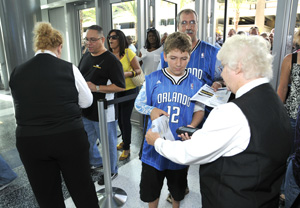 |
Devices such as ticket scanners add to the strain on wireless systems.
Photo by: City of Orlando |
“A couple of dynamics are taking place,” he said. “Once fans realize they have connectivity, all of a sudden utilization goes through the roof. Couple that with the new applications team owners want to run and it’s another element of data requirement pushed through these networks.”
In New Orleans, AT&T took the lead and paid for a $20 million distributed antenna system covering the Superdome, New Orleans Arena and Champions Square, an outdoor hospitality space between the two buildings. The deal calls for AT&T to share the cost equally with other carriers as they join the network.
Verizon, an NFL sponsor, joined the network and Sprint and T-Mobile have expressed interest in joining the system, Stewart said. The new system, installed late last year prior to the Super Bowl, runs off an enormous 1,000-kilowatt generator and has the capacity to run continuously for 48 hours, he said.
The system runs independently from the dome’s main power grid and kept operating during the infamous Super Bowl blackout. The $20 million price tag covers the custom design of back-of-house equipment to address flood elevation concerns, Stewart said.
In tandem, Verizon installed an $8 million high-density Wi-Fi network covering the same three venues. It runs on the same business model, he said.
Together, the two systems processed 73,000 phone calls and 24 million incoming and outgoing tweets during the Super Bowl. Total data consumption for the event increased 80 percent over the 2012 Super Bowl in Indianapolis.
“This is the future, if we want to start sending proprietary content,” Stewart said. “Fast forward three to five years and 90 percent [of venues] will have a robust system in place. Fast forward another three years and it will be inconceivable that we didn’t have this years ago.”
Keeping up with the technology curve
The Superdome is 38 years old, but take a look at four much-newer venues to get a greater sense for how mobile technology and consumer habits have reshaped the fan experience.
AT&T Stadium (formerly Cowboys Stadium), Amway Center, MetLife Stadium and Consol Energy Center all showcased cutting-edge technology when they opened in 2009 and 2010. Three to four years later, all four venues are investing capital to improve connectivity at their buildings.
In Arlington, the Cowboys are giving their Wi-Fi system a major facelift, replacing the stadium’s 900 older AT&T access points with new hardware produced by Cisco. The project is tied to the Cowboys’ freshly announced naming-rights deal with AT&T.
The project extends to installing 350 additional access points in the seating bowl to improve coverage, with the ability to expand Wi-Fi to the plazas and parking lots outside the stadium for special events, said John Winborn, the club’s chief information officer.
The Cowboys are covering the investment, a total cost under $10 million, said Stephen Jones, executive vice president and chief operating officer, and son of team owner Jerry Jones. When it’s up and running, more than 30,000 fans will be able to access the system simultaneously, Jones said.
The Jones family knew that to keep attracting mega events such as the 2014 NCAA Final Four, set for April at AT&T Stadium, the building must stay current with wireless technology to meet the demand for improved connectivity, Winborn said.
“The new technology is much better for this environment,” he said. “The 5 gigahertz spectrum is starting to come into play with the newest phones so we need to be prepared for that as well.”
All told, up to 1,700 access points will cover the stadium campus for the Final Four and other events such as the
Cowboys Classic college football game. This year’s Labor Day weekend contest between LSU and TCU will serve as a dress rehearsal for the wireless upgrades.
“The ultimate challenge is connecting [up to] 100,000 people simultaneously and do things like watch video,” said Cisco’s Holland. “In Dallas, each one of those access points will serve 100 to 200 people. Before, it was just a few antennas trying to serve the entire venue for Wi-Fi.”
At Amway Center, the Orlando Magic invested $500,000 over the past year to boost the number of Wi-Fi access points in conjunction with Harris Corp., the team’s official technology partner and the company that installed the original system.
Over the first three seasons at their new arena, the Magic have seen user trends shift with advancements in mobile technology, causing significant slowdowns to the Wi-Fi system, said Alex Martins, the team’s CEO.
More people connecting to the network were requiring more bandwidth and wanting to use Wi-Fi for longer periods of time, Martins said. Last season, the arena’s peak user count was 3,215 for the Los Angeles Lakers game in March, almost 1,000 more than the average number of Wi-Fi guests per game.
“When we opened [in October 2010] we felt we had enough wireless capacity,” Amway Center’s manager Johnson said. “Now, the newer phones are bandwidth hogs. Our courtside food servers work off of wireless devices and they have trouble getting their orders in.”
The recent upgrades have resolved the slowdowns, but Martins predicts that as the team develops a new mobile application, the technology will put additional strain on the Wi-Fi network.
“Whether it’s video or photos, we intend to put it on our application and there will be more fans interacting with it in our building,” Martins said. “We have to make sure it handles the additional users and that means having to make additional investments in technology.”



